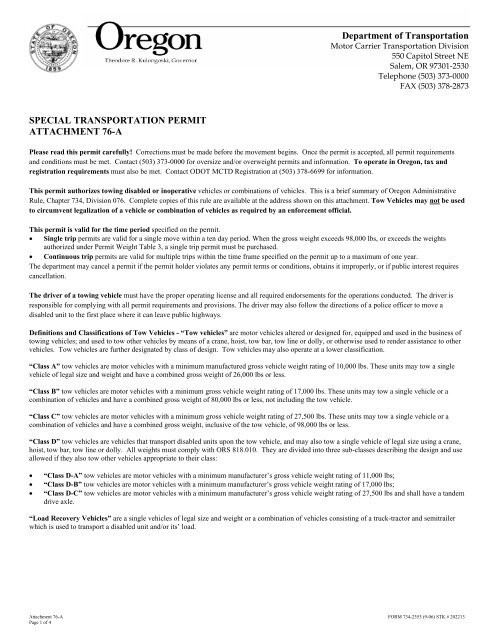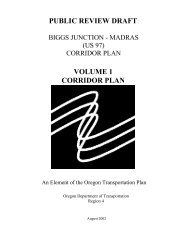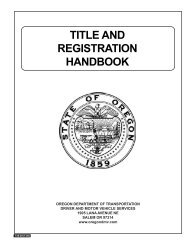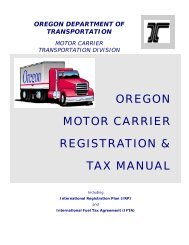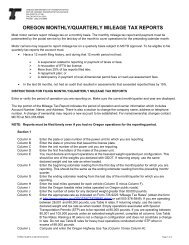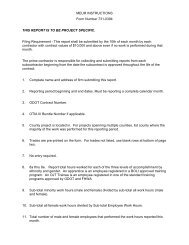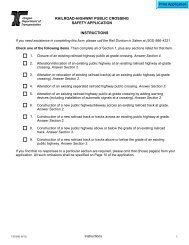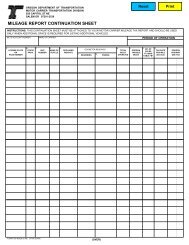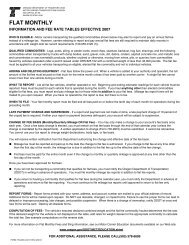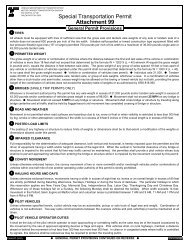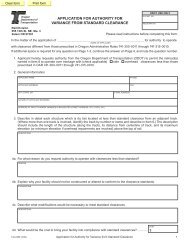SPECIAL TRANSPORTATION PERMIT ATTACHMENT 76-A ...
SPECIAL TRANSPORTATION PERMIT ATTACHMENT 76-A ...
SPECIAL TRANSPORTATION PERMIT ATTACHMENT 76-A ...
You also want an ePaper? Increase the reach of your titles
YUMPU automatically turns print PDFs into web optimized ePapers that Google loves.
<strong>SPECIAL</strong> <strong>TRANSPORTATION</strong> <strong>PERMIT</strong><br />
<strong>ATTACHMENT</strong> <strong>76</strong>-A<br />
Department of Transportation<br />
Motor Carrier Transportation Division<br />
550 Capitol Street NE<br />
Salem, OR 97301-2530<br />
Telephone (503) 373-0000<br />
FAX (503) 378-2873<br />
Please read this permit carefully! Corrections must be made before the movement begins. Once the permit is accepted, all permit requirements<br />
and conditions must be met. Contact (503) 373-0000 for oversize and/or overweight permits and information. To operate in Oregon, tax and<br />
registration requirements must also be met. Contact ODOT MCTD Registration at (503) 378-6699 for information.<br />
This permit authorizes towing disabled or inoperative vehicles or combinations of vehicles. This is a brief summary of Oregon Administrative<br />
Rule, Chapter 734, Division 0<strong>76</strong>. Complete copies of this rule are available at the address shown on this attachment. Tow Vehicles may not be used<br />
to circumvent legalization of a vehicle or combination of vehicles as required by an enforcement official.<br />
This permit is valid for the time period specified on the permit.<br />
• Single trip permits are valid for a single move within a ten day period. When the gross weight exceeds 98,000 lbs, or exceeds the weights<br />
authorized under Permit Weight Table 3, a single trip permit must be purchased.<br />
• Continuous trip permits are valid for multiple trips within the time frame specified on the permit up to a maximum of one year.<br />
The department may cancel a permit if the permit holder violates any permit terms or conditions, obtains it improperly, or if public interest requires<br />
cancellation.<br />
The driver of a towing vehicle must have the proper operating license and all required endorsements for the operations conducted. The driver is<br />
responsible for complying with all permit requirements and provisions. The driver may also follow the directions of a police officer to move a<br />
disabled unit to the first place where it can leave public highways.<br />
Definitions and Classifications of Tow Vehicles - “Tow vehicles” are motor vehicles altered or designed for, equipped and used in the business of<br />
towing vehicles; and used to tow other vehicles by means of a crane, hoist, tow bar, tow line or dolly, or otherwise used to render assistance to other<br />
vehicles. Tow vehicles are further designated by class of design. Tow vehicles may also operate at a lower classification.<br />
“Class A” tow vehicles are motor vehicles with a minimum manufactured gross vehicle weight rating of 10,000 lbs. These units may tow a single<br />
vehicle of legal size and weight and have a combined gross weight of 26,000 lbs or less.<br />
“Class B” tow vehicles are motor vehicles with a minimum gross vehicle weight rating of 17,000 lbs. These units may tow a single vehicle or a<br />
combination of vehicles and have a combined gross weight of 80,000 lbs or less, not including the tow vehicle.<br />
“Class C” tow vehicles are motor vehicles with a minimum gross vehicle weight rating of 27,500 lbs. These units may tow a single vehicle or a<br />
combination of vehicles and have a combined gross weight, inclusive of the tow vehicle, of 98,000 lbs or less.<br />
“Class D” tow vehicles are vehicles that transport disabled units upon the tow vehicle, and may also tow a single vehicle of legal size using a crane,<br />
hoist, tow bar, tow line or dolly. All weights must comply with ORS 818.010. They are divided into three sub-classes describing the design and use<br />
allowed if they also tow other vehicles appropriate to their class:<br />
• “Class D-A” tow vehicles are motor vehicles with a minimum manufacturer’s gross vehicle weight rating of 11,000 lbs;<br />
• “Class D-B” tow vehicles are motor vehicles with a minimum manufacturer’s gross vehicle weight rating of 17,000 lbs;<br />
• “Class D-C” tow vehicles are motor vehicles with a minimum manufacturer’s gross vehicle weight rating of 27,500 lbs and shall have a tandem<br />
drive axle.<br />
“Load Recovery Vehicles” are a single vehicles of legal size and weight or a combination of vehicles consisting of a truck-tractor and semitrailer<br />
which is used to transport a disabled unit and/or its’ load.<br />
Attachment <strong>76</strong>-A FORM 734-2353 (9-06) STK # 202213<br />
Page 1 of 4
“Towing vehicles” include:<br />
“Full Log Truck” means a motor vehicle having a minimum GVWR of 17,001 lbs. and designed to transport a load of logs entirely on the motor<br />
vehicle.<br />
“Log Truck” means a motor vehicle having a minimum GVWR of 17,001 lbs. and designed and used in conjunction with a pole trailer to transport<br />
one load of logs where one end of the logs rests upon the log truck and one end of the logs rest upon the pole trailer.<br />
TOW VEHICLE AUTHORIZED USE:<br />
• Class A tow vehicles shall tow a combination of vehicles only the distance necessary to leave the public highways.<br />
• Class B and C tow vehicles may tow a combination of vehicles to the nearest population center of 15,000 or 100 miles, whichever is greater.<br />
There is no restriction on the distance when towing a single vehicle.<br />
• Class D tow vehicles are not authorized to tow more than one vehicle.<br />
• A truck-tractor semitrailer load recovery vehicle may transport only the load of a disabled unit from the site of the incident to the nearest<br />
population center of at least 15,000 or 100 miles, whichever is greater. The weight may exceed that stated in ORS 818.010 provided the weight<br />
does not exceed that allowed by OAR 734-0<strong>76</strong>-0145.<br />
• A solo recovery vehicle used to transport only the load of a disabled vehicle must be of comparable size to the disabled vehicle.<br />
• A log truck or full log truck “towing vehicle” may tow an empty disabled log truck, a disabled log truck with a decked pole trailer, a loaded or<br />
unladen disabled full log truck, a disabled motor truck modified to transport logs with a trailer decked, or a loaded disabled log truck and pole<br />
trailer combination. A laden disabled log truck and pole trailer combination may be towed only to a destination mill or the motor carrier<br />
terminal, whichever is closer.<br />
WEIGHT OF TOW VEHICLE - Maximum weight for tow vehicles are as follows:<br />
• Class A and Class D tow vehicles shall conform to the weights shown in ORS 818.010.<br />
• Log Truck and Full Log Truck towing vehicles shall conform to the weights shown in ORS 818.010.<br />
• All classes of tow vehicles shall conform to ORS 818.010 when towing a disabled unit by draw bar or tow chain method.<br />
When any portion of weight of the disabled unit rests upon a Class B or Class C tow vehicle:<br />
• Weight per tire may not exceed 600 lbs per inch of tire width up to:<br />
• 23,000 lbs on a single drive axle; or<br />
• 46,000 lbs on a tandem drive axle; or<br />
• The weight allowed by Permit Weight Table 3 for any group of 3 or more axles.<br />
The steering axle of the towing vehicle must carry sufficient weight required to maintain a safe operation; and,<br />
• The steering axle of all Class B tow vehicles shall weigh no less than 3,000 lbs at any time.<br />
• The steering axle of all Class C tow vehicles shall weigh no less than 3,500 lbs at any time.<br />
WEIGHT OF DISABLED UNIT - Maximum weight for disabled units are as follows:<br />
• When being towed by a Class A or any Class D tow vehicle, all weights shall conform to ORS 818.010<br />
• When being towed by a Class B or Class C tow vehicle or a Full Log Truck or Log Truck towing vehicle using a draw bar or tow chain method<br />
the weight of the disabled unit shall conform to ORS 818.010 or to the Special Transportation Permit issued to the disabled unit; and<br />
• When a Class B or Class C tow vehicle carries a portion of the weight of the disabled unit, the first load bearing axle(s) of the disabled unit may<br />
weigh 600 lbs per inch of total tire width, not to exceed 21,500 lbs for any single axle or 43,000 lbs for a tandem axle, unless a Special<br />
Transportation Permit applicable to the disabled unit authorizes a higher weight.<br />
• A truck-tractor semitrailer load recovery vehicle may transport a divisible or non-divisible load. Except when operating under a single trip<br />
permit, the weight shall not exceed 600 lbs per inch of tire width, 21,500 lbs on a single axle or 43,000 lbs on a tandem axle and weights stated<br />
in Permit Weight Table 3, not to exceed 98,000 lbs. Lift axles must be deployed when axle weights exceed that allowed under ORS 818.010.<br />
• A solo recovery vehicle may transport a non-divisible load and the weight shall not exceed 600 lbs per inch of tire width, 21,500 lbs on a single<br />
axle or 43,000 lbs on a tandem axle and not exceed the weights stated in Permit Weight Table 3.<br />
HEIGHT AND WIDTH - No disabled unit including load, shall exceed 14 feet in height or 8 feet 6 inches in width, except:<br />
• When initially operating under a Special Transportation Permit allowing a greater height or width issued to the disabled unit. The allowances<br />
granted by that permit shall apply only to movement over highways described in the permit; or,<br />
• Where an accident or collision has resulted in a width greater than 8 feet 6 inches, but not exceeding 10 feet in width. In that event, during<br />
daylight hours the extreme width shall be marked by red flags not less than 18 inches square (effective date 1/1/07); and during the hours of<br />
darkness the extreme width shall be marked by clearance lights or markers described in ORS Chapter 816.<br />
• Rear view mirrors may exceed the width authorized by the Special Transportation Permit by 5 inches on each side, but must be retracted to legal<br />
width when an overwidth disabled unit is not being transported.<br />
LENGTH - Class A, B, C tow vehicles and Log Truck, and Full Log Truck towing vehicles may not exceed 40 feet in length. Class D tow vehicles<br />
may not exceed 45 feet in length. The length of any towed vehicle shall not exceed the length established by statute or rule unless authorized by a<br />
Special Transportation Permit issued to the vehicle. The length of a laden disabled log truck/pole trailer shall not exceed the lengths established by<br />
OAR 734-071-0010. Combination length of towed vehicles may be temporarily extended when being towed provided the combination was of legal<br />
length prior to the incident.<br />
Attachment <strong>76</strong>-A FORM 734-2353 (9-06) STK # 202213<br />
Page 2 of 4
APPROVED ROUTES - When removing a load or vehicle from the initial emergency, tow vehicles or load recovery vehicles operating under this<br />
rule may operate on all state highways as directed by an enforcement officer. Thereafter, tow vehicles may operate over any route approved for the<br />
disabled vehicle(s) prior to the incident; load recovery vehicles may operate over approved routes and at the lengths authorized on Group Map 1 or<br />
Route Map 7 or those routes shown on the Special Transportation Permit issued to the disabled vehicle. See Route Map 2 for weight restricted<br />
highways and bridges.<br />
Except when responding to initial emergency, overwidth movement is not allowed: 1) When wind or other conditions may cause the vehicle or<br />
vehicles to swerve, to whip, to sway, or fail to follow substantially in the path of the towing vehicle; 2) When road surfaces are hazardous due to ice,<br />
snow or frost; 3) When visibility is less than 500 feet due to snow, mist, rain, dust, smoke, fog or other atmospheric conditions.<br />
Except when performing the initial emergency removal of the disabled unit from the highway; or when operating under the rule applicable to the<br />
original variance permit issued to the disabled vehicle, the following shall apply:<br />
WIDTH Travel during<br />
hours of<br />
darkness on<br />
Route Map 2<br />
Green Routes<br />
with lights on<br />
outermost<br />
points - year<br />
round except observed<br />
holidays<br />
HAULING HOURS AND DAYS FOR OVERWIDTH MOVEMENT<br />
Daylight travel<br />
Saturday<br />
Afternoon and<br />
Sunday<br />
from<br />
Memorial Day (last<br />
Monday in May)<br />
To<br />
Labor Day (first<br />
Monday in September)<br />
OBSERVED HOLIDAYS<br />
New Year’s Day, Memorial Day, Independence Day, Labor<br />
Day and Christmas Day<br />
From 2PM on Last Business Day Preceding observed<br />
Holiday through ½ hour before Sunrise of 1st Business Day<br />
following observed Holiday.<br />
THANKSGIVING<br />
From Noon Wednesday before Thanksgiving to 1/2 hour<br />
before Sunrise on Monday following Thanksgiving<br />
Up to 8'06" Allowed Allowed Allowed<br />
Over 8'06"to 10' Allowed Not Allowed Not Allowed<br />
Over 10'0" As specified by the variance permit issued to original disabled vehicle or by single trip permit<br />
Business day is any day Monday through Friday, except holidays. Daylight hours means one-half hour before sunrise until one-half hour after<br />
sunset.<br />
Pilot vehicles are considered to be under the direct control and supervision of the towing vehicle operator. Pilot vehicles may be a passenger car,<br />
pick-up, truck, or truck tractor of legal size and weight. A pilot vehicle shall not tow a vehicle. Pilot vehicles are to be placed 300 feet to 500 feet<br />
from the oversize load or as appropriate to properly safeguard the traveling public. the unless otherwise specified on the permit. Pilot vehicle duties<br />
and required equipment are specified in OAR Chapter 734 Division <strong>76</strong>. A complete copy of this rule is available at the address shown on page one of<br />
this attachment.<br />
WIDTH<br />
Interstate &<br />
Multilane<br />
Highways<br />
MINIMUM PILOT VEHICLES REQUIRED<br />
Route Map 2<br />
Green routes<br />
Route Map 2<br />
Purple routes<br />
Group Map 1<br />
Group 1<br />
Highways<br />
Group Map 1<br />
Group 2<br />
Highways<br />
Group Map 1<br />
Group 3<br />
Highways<br />
Over 8'06" to 09'00" None None None None One Two<br />
Over 9'00" to 10'00" None None One One One Two<br />
Over 10'0" As specified by variance permit issued to original disabled vehicle or by single trip permit<br />
OVERALL<br />
LENGTH<br />
Over 95'0" to 120'0"<br />
None<br />
None<br />
One<br />
One<br />
Two<br />
Two<br />
When one pilot vehicle is required, it shall travel in front of the oversize unit. When two pilot vehicles are required, one shall be in front and one<br />
shall be at the rear of the oversize unit.<br />
Warning signs are required for dimensions exceeding 8 feet 6 inches in width and 105 feet in overall length (inclusive of towing vehicle) or 80 feet<br />
in length for a combination of vehicles being towed (inclusive of load). Warning signs shall be displayed to the front and rear of the vehicle or<br />
combination of vehicles. Signs shall be 7 feet wide by 18 inches high with black letters 10 inches high with 1-5/8 inch brush stroke in accordance<br />
with Federal Highway Administration series C on highway yellow background. The highway yellow background of the sign shall be made of<br />
reflectorized material when operating between one half hour after sunset and one half hour before sunrise. Warning signs shall bear the legend<br />
“OVERSIZE LOAD” or;<br />
1) When width exceeds 8 feet 6 inches and the combination of vehicles towed does not exceed 80 feet in length (inclusive of load) or the overall<br />
combination length does not exceed 105 feet (inclusive of towing vehicle), the sign may bear the legend “WIDE LOAD;”<br />
2) When width does not exceed 8 feet 6 inches and the combination of vehicles being towed exceeds 80 feet in length (inclusive of load) or the<br />
overall combination length exceeds 105 feet (inclusive of towing vehicle), the sign may bear the legend “LONG LOAD.”<br />
Attachment <strong>76</strong>-A FORM 734-2353 (9-06) STK # 202213<br />
Page 3 of 4
Overwidth loads must be marked at the outermost extremities during daylight hours with red flags not less than 18 inches square, visible to the<br />
front and rear. The attachment device shall not extend beyond the widest extremity by more than 3 inches on either side. Loads up to 10 feet wide<br />
traveling at night must have marker lights at the outermost points of the load. Loads extending beyond the rear of the load-carrying part of the<br />
vehicle 4 feet or more, shall be visibly marked with a red flag not less than 18 inches square attached to the outermost extremity of the load. The<br />
attachment device shall not extend beyond the rear of the load more than 3 inches.<br />
The following mandatory equipment is required for log truck and full log truck towing vehicles in addition to any other lights or equipment<br />
required by statue or rule:<br />
• When towing a vehicle or combination of vehicles, a minimum of two safety chains shall be used.<br />
• When towing a combination of vehicles over a highway, operable brakes are required on each vehicle in the combination except towed power<br />
units equipped with air brakes. When brakes are required, brakes must be controlled from the cab of the towing vehicle.<br />
• Exception: When a log truck or full log truck “towing vehicle” is towing a disabled log truck-pole trailer, the disabled log truck may be<br />
operated by a driver steering the disabled log truck-pole trailer combination controlling the brakes of the towed vehicle(s) and operating<br />
lights including, but not limited to, tail lights, stop lights and turn signals.<br />
• When the towed vehicle is occupied by a driver, there must be a two way audio communication system allowing the drivers of the towed vehicle<br />
and the towing vehicle to communicate.<br />
• The rear vehicle being towed shall be equipped with operable lights including, but not limited to, tail lights, stop lights and turn signals.<br />
MINIMUM MANDATORY EQUIPMENT FOR TOW VEHICLES<br />
ITEM CLASS A CLASS B CLASS C CLASS D-A CLASS D-B CLASS D-C<br />
If equipped, If equipped, If equipped,<br />
Boom rating 12,000 lb. 20,000 lb. 50,000 lb. 12,000 lb. 20,000 lb. 50,000 lb.<br />
2-Way radio<br />
Brakes required on<br />
Required Required Required Required Required Required<br />
each vehicle except<br />
Required when Required when Required when<br />
towed power units<br />
with air brakes<br />
Required Required Required towing vehicle towing vehicle towing vehicle<br />
Broom and Shovel<br />
Cable Diameter<br />
Required Required Required Required Required Required<br />
3/8 inch 7/16 inch 5/8 inch 3/8 inch<br />
7/16 inch<br />
5/8 inch<br />
Cable Length<br />
Fire extinguisher 25<br />
100 feet 150 feet 150 feet 50 feet 50 feet 50 feet<br />
BC rating or<br />
equivalent<br />
Required Required Required Required Required Required<br />
Pinch bars One Two<br />
Required unless<br />
Two One Two Two<br />
Portable dolly Required GVW is more than Not<br />
Not<br />
Not<br />
Not<br />
23,000 lb. Required Required Required Required<br />
Portable lights for<br />
Required when Required when Required when<br />
disabled unit<br />
Revolving or<br />
intermittent Red or<br />
Required Required Required towing vehicle towing vehicle towing vehicle<br />
amber warning light<br />
360º visibility<br />
Required Required Required Required Required Required<br />
Safety Chains when<br />
Two<br />
Two<br />
Two<br />
towing vehicle(s) Two<br />
Two<br />
Two When towing When towing When towing<br />
vehicle<br />
vehicle<br />
vehicle<br />
Snatch block<br />
Tow sling, wheel lift,<br />
Required Required Required Required Required Required<br />
car carrier or other Adequate for Adequate for Adequate for Adequate for Adequate for Adequate for<br />
connection<br />
Work area light<br />
towed vehicle towed vehicle towed vehicle towed vehicle towed vehicle towed vehicle<br />
mounted behind Cab<br />
“Wreck Ahead” sign<br />
Required Required Required Required Required Required<br />
Required Required Required Required Required Required<br />
Attachment <strong>76</strong>-A FORM 734-2353 (9-06) STK # 202213<br />
Page 4 of 4


